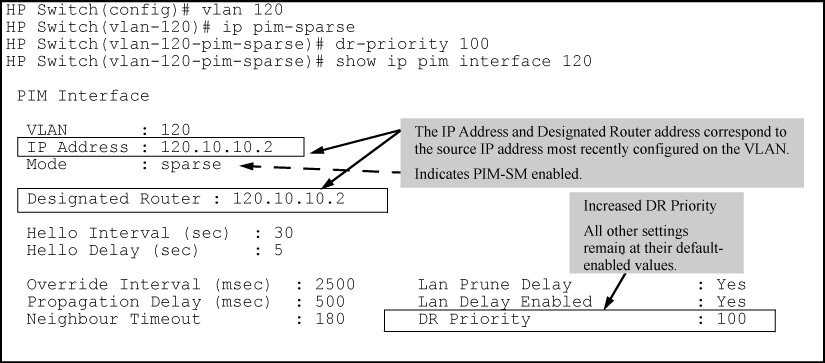PIM-SM must be configured on at least one VLAN in the router before it can be configured as a C-BSR or a C-RP.
IGMP must be enabled in VLANs on edge routers where multicast receivers (end points) are connected and will be requesting to join multicast groups.
Syntax:
Enables or disables IGMP operation in the current VLAN. Configuring IGMP on the router is required in VLANs supporting edge router operation. See Configuring PIM-DM on a routing switch at the global level.
Syntax:
ip pim-sparse[ip-addr [any|ip-addr] ]
vlan [[vid] ip pim-sparseip-addr [any|ip-addr] ]
no[vlan [vid]] ip pim-sparseThis command enables or disables PIM-SM in the designated VLAN interface and sets the source (and designated router) IP address for PIM-SM packets sent from the interface. Executing the command without specifying an IP address option causes the router to default to the
anyoption, below. (Default: PIM-SM disabled)
Syntax:
Changes the frequency at which the router transmits PIM hello messages on the current VLAN. The router uses hello packets to inform neighbor routers of its presence.
The router also uses this setting to compute the hello hold time, which is included in hello packets sent to neighbor routers. hello hold time tells neighbor routers how long to wait for the next hello packet from the router. If another packet does not arrive within that time, the router removes the neighbor adjacency on that VLAN from the routing table, which removes any flows running on that interface.
Shortening the hello interval reduces the hello hold time. This changes how quickly other routers will stop sending traffic to the router if they do not receive a new hello packet when expected. For example, if multiple routers are connected to the same VLAN and the router requests multicast traffic, all routers on the VLAN receive that traffic. (Those that have pruned the traffic will drop it when they receive it.) If the upstream router loses contact with the router receiving the multicast traffic (that is, fails to receive a hello packet when expected), the shorter hello interval causes it to stop transmitting multicast traffic onto the VLAN sooner, resulting in less unnecessary bandwidth use.
Syntax:
Changes the maximum time in seconds before the router actually transmits the initial PIM hello message on the current VLAN. In cases where a new VLAN activates with connections to multiple routers, if all of the connected routers sent hello packets at the same time, the receiving router could become momentarily overloaded. This value randomizes the transmission delay to a time between 0 and the hello delay setting. Using 0 means no delay.
After the router sends the initial hello packet to a newly detected VLAN interface, it sends subsequent hello packets according to the current Hello Interval setting.
Syntax:
Enables the LAN prune delay option on the current VLAN. With
lan-prune-delayenabled, the router informs downstream neighbors how long it will wait before pruning a flow after receiving a prune request.Other downstream routers on the same VLAN must send a join to override the prune before the
lan-prune-delaytime if they want the flow to continue. This prompts any downstream neighbors with multicast receivers continuing to belong to the flow to reply with a join. If no joins are received after thelan-prune-delayperiod, the router prunes the flow.The
propagation-delayandoverride-intervalsettings (below) determine thelan-prune-delaysetting.Uses the
noform of the command to disable theLAN prune delayoption.
Syntax:
A router sharing a VLAN with other multicast routers uses these two values to compute the
lan-prune-delaysetting (above) for how long to wait for a PIM-SM join after receiving a prune packet from downstream for a particular multicast group.Multiple routers sharing VLAN
A network may have multiple routers sharing VLAN "X." When an upstream router is forwarding traffic from multicast group "X" to VLAN "Y," if one of the routers on VLAN "Y" does not want this traffic, it issues a prune response to the upstream neighbor. The upstream neighbor then goes into a prune pending state for group "X" on VLAN "Y." (During this period, the upstream neighbor continues to forward the traffic.) During the pending period, another router on VLAN "Y" can send a group "X" join to the upstream neighbor. If this happens, the upstream neighbor drops the prune pending state and continues forwarding the traffic. But if no routers on the VLAN send a join, the upstream router prunes group "X" from VLAN "Y" when the
lan-prune-delaytimer expires.(Defaults:
propagation-delay= 500 milliseconds;override-interval= 2500 milliseconds)
Syntax:
This command changes the router priority for the DR election process in the current VLAN. A numerically higher value means a higher priority. If the highest priority is shared by multiple routers in the same VLAN, the router with the highest IP address is selected as the DR.
A 0 (zero) value disables DR operation for the router on the current VLAN.
PIM-SM support must be configured in each VLAN where you want PIM-SM forwarding of multicast traffic. This illustrates the following per-VLAN configuration steps:
-
Enabling PIM-SM on VLAN 120 and allowing the default
anyoption to select a source IP address for PIM-SM packets forwarded from this VLAN. (Because the VLAN in this example is configured with only one IP address—120-10.10.2—it is this address that will be used for the source.) -
Increasing the DR priority on this VLAN from the default 1 to 100.
-
Leaving the other per-VLAN PIM-SM fields in their default settings.
![[NOTE: ]](images/note.gif)
